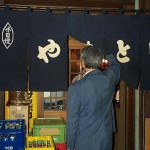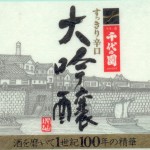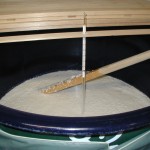 Currently, there are about 1250 sakagura (sake breweries) licensed to brew sake in Japan (although not all of them are brewing actively). And, amongst these 1250 breweries are about 5,000 brand names, or “meigara.” Of course, not all of these are actively being used, but on the average each brewery has the rights to about five brand names.
Currently, there are about 1250 sakagura (sake breweries) licensed to brew sake in Japan (although not all of them are brewing actively). And, amongst these 1250 breweries are about 5,000 brand names, or “meigara.” Of course, not all of these are actively being used, but on the average each brewery has the rights to about five brand names.
But it wasn’t always this way. In fact, until about 600 years ago, there were no “meigara.” Sake was probably referred to by the name of the company (although admittedly branding was not such an advanced business concept back then), or even more likely the temple doing the brewing. The average citizen back then might have simply called it the local hooch, or Joe’s sake (or Shinnosuke’s sake, as it were).
Back in 1425 there were in total 342 sake brewers in Kyoto alone, many of these within Kyoto’s numerous temples. One of the most popular brews came from a temple named Nishi no Touin, and after time, its popularity led to a nickname born of affection. Next to the gate at the entrance grew a willow tree, and the locals began to refer to the place as “Yanagi no Sakaya,” or “The Willow Sake Brewer.”
The noren (a short traditional curtain that hangs at the entrance of shops inJapan that  customers part and duck under when entering) at the gate of Nishi no Touin bore a crest of six stars. Eventually, the brewing priests there began to emblazon this pattern on their wooden sake casks, along with the name “Yanagi-zake,” or “Willow Sake.” Thus, the first sake “meigara” was born.
customers part and duck under when entering) at the gate of Nishi no Touin bore a crest of six stars. Eventually, the brewing priests there began to emblazon this pattern on their wooden sake casks, along with the name “Yanagi-zake,” or “Willow Sake.” Thus, the first sake “meigara” was born.
Well, wouldn’t you know it, soon everybody had one of these meigara thingies. Taking names from “waka,” (traditional Japanese songs), or requesting aristocrats and priests to decide on a suitable moniker, brewers everywhere began to assign auspicious brand names to their sake. Some of the earliest ones on record include “Sazare-ishi” (Pebbles), “Mitarashi” (Holy Washing of Hands), and “Maitsuru” (Dancing Crane). In those days, obviously there were no enforceable trademark laws, and as such many of these names were copied and used in several places. Some of the more popular copied names included “Wakamidori” (The Green of Youth), “Otoha” (The Sound of Wings), and “Ariake” (Very Early Morning). Names were chosen for good luck and image, and often referred to auspicious entities in nature, like mountains, pine trees, flowers, and turtles.
Today, there are about 5,000 meigara in active usage. The names of these are written in kanji characters, the pictographs that comprise most of the written language. What is the single most common character in use in meigara today? That would be the character for mountain, pronounced either “yama” or “san.” Next on the list is “tsuru,” the character for crane (as in bird. I doubt any sake are named after construction equipment.).
Number three and four on the list are “masa” and “mune,” almost always seen together in the combination “masamune,” and have an interesting origin to them. There are countless sake that have “masamune” as the second half of their brand name, but the very first one is said to have been Sakura Masamune from Nada in Hyogo prefecture. Sakura Masamune is a very old, famous and prestigious brewer, and eons ago their founder visited a friend that was the head priest at a hermitage called Gensei-an. There, he looked up on a bookshelf and saw a book of scripture by the Rinzai sect Zen master Rinzai Masamune. In a moment of inspiration, he realized that the characters for “masamune” could also be read “seishu,” which is a homonym for the legal term for sake. And so, the first of hundreds of meigara bearing the term “masamune” was born.
the combination “masamune,” and have an interesting origin to them. There are countless sake that have “masamune” as the second half of their brand name, but the very first one is said to have been Sakura Masamune from Nada in Hyogo prefecture. Sakura Masamune is a very old, famous and prestigious brewer, and eons ago their founder visited a friend that was the head priest at a hermitage called Gensei-an. There, he looked up on a bookshelf and saw a book of scripture by the Rinzai sect Zen master Rinzai Masamune. In a moment of inspiration, he realized that the characters for “masamune” could also be read “seishu,” which is a homonym for the legal term for sake. And so, the first of hundreds of meigara bearing the term “masamune” was born.
Note, there is also a theory that the name was taken from a famous sword maker named Masamune, although the homonym reasoning remains the same in this story as well.
Other commonly used characters in the top ten include “kiku” (chrysanthemum), “o-” (big), “kin” (gold), “izumi” or “sen” (spring, as in water), “haku” (white), and “hana” (flower), in that order.
Why, by the way, would a kura have more than one brand name? There are several  reasons. They may have merged with another kura at one point in time in one of the several economic and wartime decimations of the sake industry that have occurred. Or, they may have created a new brand with a better image, especially when distribution channels allowed their sake to get to larger national markets, but kept the old brand name for the local fans.
reasons. They may have merged with another kura at one point in time in one of the several economic and wartime decimations of the sake industry that have occurred. Or, they may have created a new brand with a better image, especially when distribution channels allowed their sake to get to larger national markets, but kept the old brand name for the local fans.
The sake industry seems unique and can often be confusing since the name of the owner, the name of the company, and the brand name of the product are all very different. Confusing though it may be, at least there is a history to it!




